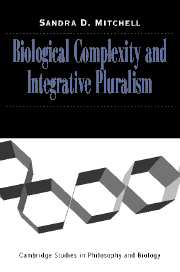3 - Dynamic Complexity
Published online by Cambridge University Press: 05 June 2012
Summary
Understanding the dynamical mechanisms by which complex organization is built can provide important insights into the evolution of complexity. Indeed, adopting an “adaptationist” view of the biological world, where all atomized structures are thought to be the result of direct selection over variation for fitness consequences, systematically ignores the role that development of structure plays in evolutionary history. In this chapter, written by Robert E. Page and Sandra Mitchell, we attempt to take seriously the developmentalist challenge. That is, if we can see how division of labor and other features of social insect colonies might arise, we can better understand which features of a complex phenotype were available for variation and possible selection in the evolution of sociality.
Self-organization refers to a family of agent-based models for generating “order” at a higher level from the interaction of components at a lower level without requiring the resulting structure be coded for in genetic blueprints or be solely a result of centralized control structures. The models that we have developed were inspired by Stuart Kauffman's N-K Boolean networks (Kauffman 1993). We imbued the individual computer bees with characteristics found in solitary bees and ran simulations to determine which features would result from the mere interaction of such individuals. The results were interesting. Division of labor emerged “spontaneously” from the self-organizing dynamics of our model.
- Type
- Chapter
- Information
- Biological Complexity and Integrative Pluralism , pp. 38 - 57Publisher: Cambridge University PressPrint publication year: 2003

